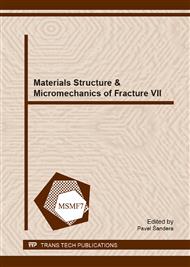p.233
p.239
p.246
p.250
p.254
p.258
p.262
p.266
p.271
Fatigue Crack Propagation in Steels for Railway Axles
Abstract:
The paper deals with the influence of order of cycles in the loading block on the fatigue crack growth rate in railway axle. The railway axle can include some cracks from manufacturing process or initiated fatigue cracks from previous operation. It is advantageous to know how the crack will behave during further service of the train to ensure its safe operation. The most common approaches describing the fatigue crack growth do not take into account the effects of overload cycles, which enlarge the plastic zone ahead of the crack tip. The enlarged plastic zone generates residual compressive stresses, which cause a retardation of the fatigue crack growth. Finite element numerical calculations were used together with the generalized Willenborg model to determine influence of overload cycles on the increment of fatigue crack growing in railway axles. Real geometry of the axle, the crack front shape and typical loading spectrum were taken into account.
Info:
Periodical:
Pages:
254-257
Citation:
Online since:
November 2013
Authors:
Price:
Сopyright:
© 2014 Trans Tech Publications Ltd. All Rights Reserved
Share:
Citation:


